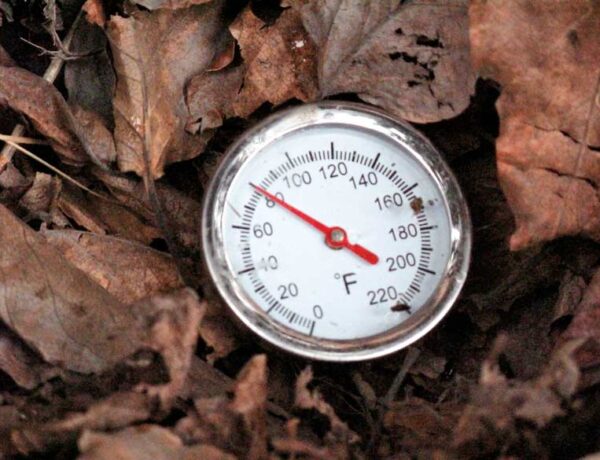Finding a perfect zucchini was a pleasant surprise, what with our wacky-weather summer. As I leaned in closer, feeling a little proud. That’s when I saw it, the gray color, not normal for a green zucchini. It was my first clue that something was in the air.
Something was in the air alright…
Mold. Ick.
Yes, after a couple of weeks of blessedly calm weather mixed with fog, conditions were perfect for gray mold to explode on zucchini fruits, and tomato leaves. and anything else standing in its way.
The Perfect Storm
Sigh. Gray mold (Botrytis cinerea) is found on a wide range of plants. If I were to list them all in this column, you’d be reading nothing but scientific names from here to the end…
No garden is immune. Gray mold is a fungal disease that travels quickly through gardens. It infects plants in outside beds as well as in enclosed spaces such as greenhouses and hoophouses. Cool, damp weather is the Perfect Storm for gray mold.
[Hi, it’s Marion. This article was originally published in the Kodiak Daily Mirror, the hometown newspaper for Kodiak, Alaska. Go here to access the archive page for the list of my past columns, written each week since 1986].
How do you identify gray mold?
If mushy spots appear on leaves, stems, flowers, and on store-bought produce, gray mold is most likely the culprit.
Sorry, but it can be nightmarish…
Given the right conditions, the mushy areas often become covered with a coating of gray fungus spores.
Here’s the thing: Gray mold easily affects plants that are already damaged or beginning to die. A good reason to keep your plants healthy!
It then spreads quickly and can cause extensive damage to the healthy parts of plants. So if you’re one of those tomato growers that can’t resist pinching and trimming suckers and leaves, then be gray mold aware…
The appearance of gray mold is not limited to garden plants, however. You’ve seen it on store-bought strawberries, oranges, and inside heads of lettuce. Have you ever sliced through a head of romaine lettuce and POOF! a cloud of gray mold erupts?
That’s not all… Gray mold can overwinter on plants, even in the soil, which is why it’s so important to clean out seedling containers and greenhouse interiors at the end of the season.
Spores develop when conditions are optimal and are transported by wind, hands, tools, clothing, or splashing water onto blossoms or young leaves, where they germinate and enter the plant.
Spores require cool temperatures (45 to 60 degrees) and high humidity (around 93 percent) to germinate. Which means, during periods of drizzle and fog, make a special effort to check your plants. Carefully and often. Molds, like aphids don’t just happen overnight.
That’s all good information, Marion, but…
10 Ways to prevent and stop gray mold
It sounds like a science fiction movie script, but gray mold exists almost everywhere–in the air, on surfaces–just waiting for the right conditions to “bloom.”
Whether you’re transplanting seedlings, watering a hanging basket or taking care of someone else’s houseplants, these tips will help prevent a mold infestation:
Slow gardening
As you work around plants, removing faded flowers or trimming leaves, move slowly and intentionally. You’re less likely to spread spores if you stay in the moment and pay attention.
Dip your tools
As an extra precaution, dip your hand tools now and then into a mild vinegar-water solution. In the greenhouse, where it’s common to grow tall sunflowers and poppies, this means cleaning up petals that fall onto plants or the soil below.
Your clothes
Avoid wearing fuzzy, fleece clothing! Gray mold likes to hitch a ride.
Keep it clean
In the vegetable garden, remove infected plants immediately after harvest. Plant tissues that are stressed, crimped, ripped or not actively growing are great hosts for gray mold to find a footing. Rhubarb plants are especially susceptible to mold at the end of the active growing season.
Give me air!
Improve sunlight and increase air circulation and don’t crowd plants. Here’s the thing: In greenhouses and hoophouses (also known as high tunnels), the less air circulation you have, the greater the chance of developing mold.
A word about automatic vents, the ones that open automatically when a temperature sensor says “open”!
Well, they don’t move enough air. You need fans to be running 24/7.
One of my favorite ways to increase air flow in the hoophouse is to hang an oscillating fan upside down and let it spin back and forth, back and forth. Efficiency by randomness.
What about cloudy days?
I’ll admit, on cloudy days it’s tempting to close the greenhouse doors and windows, thinking you need to preserve heat. Thing is, shuttering up your plants in cool, calm air is the worst thing you can do.
Best watering practices
Avoid overhead watering, especially late in the day. Keeping foliage dry is extremely important to prevent gray mold from exploding. Install a drip irrigation system or water by hand, “massaging” the soil with a gentle shower…
At the end of the season…
Clean the greenhouse and the hoophouse as best you can at the end of the season. Remember, gray mold can overwinter in the soil, in decaying plant debris, and on infected dead plant material.
To bleach or not to bleach?
Many sources recommend sterilizing used plant containers with a mild bleach or vinegar solution before re-using them. Personally, I’ve only rinsed them well in water and air-dried them. And I’ve never had an issue with damping-off or mold.
Don’t panic, grow organic!
Finally, if you want to control gray mold, your first defense is to keep your plants healthy, preferably with organic growing methods and to pay attention.
Meanwhile, here is a lovely, fruity quick bread to celebrate the berry-picking season:
Lemon-Raspberry Quick Bread
6 tablespoons butter, softened
1 cup sugar
2 eggs
1 1/2 cups unbleached flour
1 tsp baking powder
1/4 teaspoon. salt
1/2 cup milk
Grated rind of 1 lemon
3/4 cup fresh raspberries
Preheat the oven to 350 degrees. In a medium bowl, sift flour, baking powder, and salt. In another bowl, cream butter, lemon rind and sugar together. Add eggs and mix well.
Add the dry mixture to the creamed mixture alternately with the milk. Fold in raspberries. Turn into a prepared 5×9-inch loaf pan.
Bake for 50-60 minutes or until a toothpick inserted in the center comes out clean. For the glaze, stir together powdered sugar and lemon juice. After removing the bread from the oven, pierce the top all over with a fork. Drizzle lemon glaze all over the top. Cool 15-20 minutes before turning out onto a rack.
Thank you for visiting. Cheers!

More resources for you:
Hi gardeners! Want to create your dream garden? You can do it, step-by-step with Marion Owen: The Gardener’s Coach. Visit my YouTube channel: The Gardener’s Coach.
Compost is the answer to everything in the garden!
And if you have enough of it, you won’t need much of anything else. To learn more, take my 60-second assessment.





No Comments